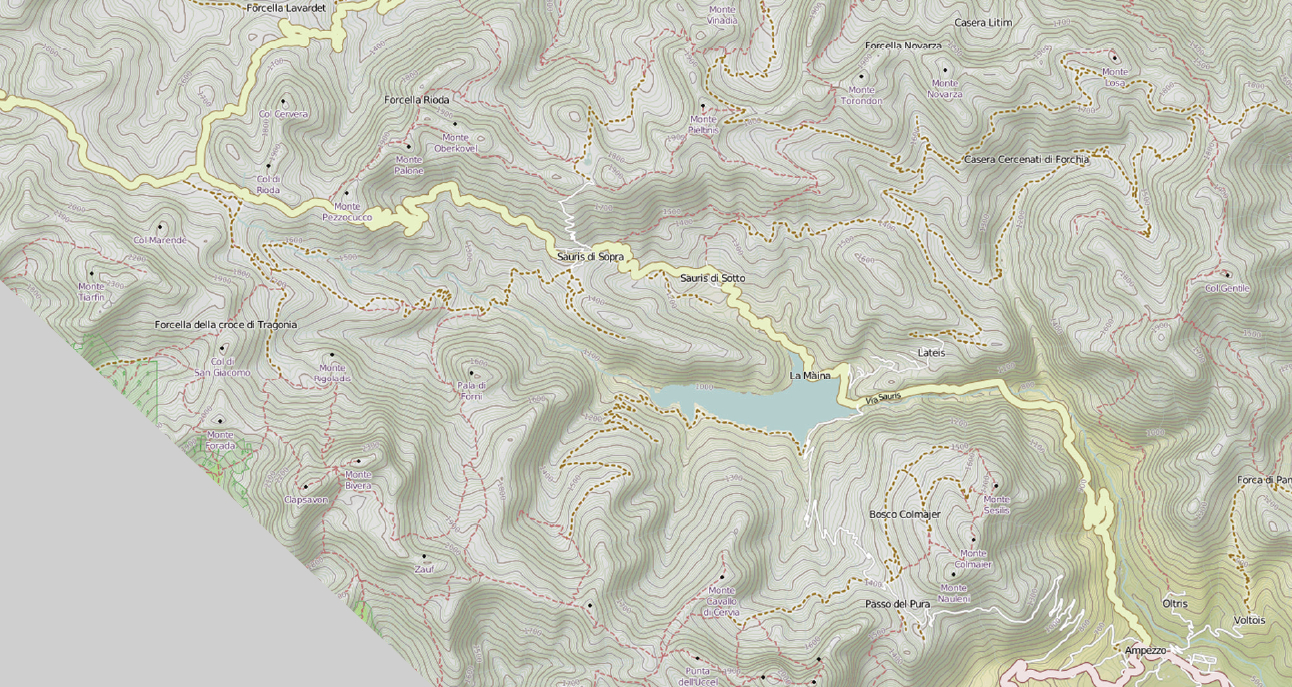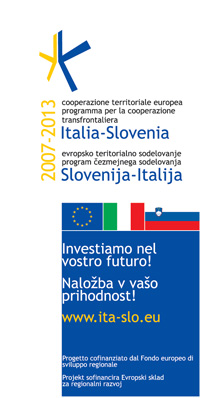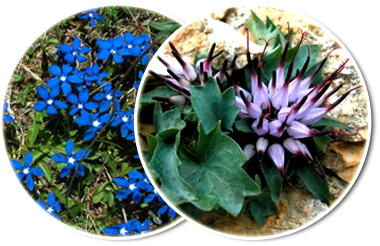Study area
This is an interactive flora of the southern portion of the Carnic Alps (Ampezzo-Sauris, Province of Udine, NE Italy), which includes 1,244 infrageneric taxa of vascular plants. The study area, centered on the Valley of Sauris, includes the whole valley of river Lumiei and extends from the valley of the Tagliamento river near Ampezzo Carnico in the Province of Udine to Mt. Tiarfin in the province of Belluno.

The Valley of Sauris, the bottom of which is now occupied by an artificial lake, is closed to the north and to the east by mountains which are higher than 2,000 m (Mt. Pieltinis , Mt. Tarondon, Mt. Novarza , Mt. Col Gentile ), consisting of powerful layers of Werfen sandstones. To the southwest it is limited by the highest peaks, which reach 2,400 m (Mt. Bivera, Mt. Clapsavon , Mt. Tiarfin ) and consist of limestone and dolomite of the Anisic and Ladinian periods. Recent sediments occupy the valley floors at Ampezzo. A comprehensive description of the territory is in AA.VV. (1983), to which we refer for further details. The first floristic reports from the survey area date back to Gortani (1906 Vol II). Pignatti & Pignatti (1968) provided a first sketch of the flora and vegetation. The first full checklist ( Pignatti & Poldini, 1969), included 664 infrageneric taxa , which soon rose to 997 in the Chorological Atlas by Poldini (1991) and to more than 1,000 in its second edition (Poldini 2002).
Every year, the dichotomous key incorporated into this portal is being tested by students of the University of Trieste at the Center for Alpine Botanical Studies in Passo Pura ( Ampezzo ). The first version was published by Nimis & Martellos (2005); this is the English translation of the seventh version in Italian, published both online (August 2013) and in book form (Nimis et al., 2013). The English version of the portal and of the correponding dichotomopus key was mainly prepared in order to be used by students of the University of Manchester, during a summer course at Passo Pura in July 2014.
The breakdown in Families follows Angiosperm Phylogeny Group III (APG 2009).
The guide has been prepared in the framework of Project SiiT (Interactive Tools for Identifying Biodiversity: an educational project in transborder area), funded under the Cooperation Programme Italy-Slovenia 2007-2013 by the European Regional Development Fund and by national funds.
Literature
AA.VV. (1983). Ambiente e Cultura di una montagna carnica. Il Tinisa. Ed. Lint, Trieste, 195 pp.
APG (2009). An update of the Angiosperm Phylogeny Group classification for the orders and families of flowering plants: APG III. Bot. J. Linn. Soc. 161(2): 105-121.
GORTANI L., GORTANI M. (1905-1906). Flora Friulana con speciale riguardo alla Carnia. Udine.
NIMIS P.L., MARTELLOS S. (2005). Guide alla Flora I - Le Guide di Dryades, 2. Ed. Goliardiche, Trieste, 380 pp.
NIMIS P.L., MORO A., MARTELLOS S. (2013). Guida alla flora delle Alpi Carniche meridionali (Ampezzo-Sauris). EUT, Trieste, ISBN 978-88-8303-487-9
PIGNATTI E., PIGNATTI S. (1968). Botanische Wanderungen in den Karnischen Alpen. Sauris, eine deutsche Sprachinsel. Ver z. Sch. d. Alpenpflanzen u.Tiere, 33: 90-99.
PIGNATTI S., POLDINI L. (1969). Florula della Conca di Sauris (Alpi Carniche). Boll. Soc. Adr. Sc. Trieste, 57: 66-93.
POLDINI L. (1991). Atlante corologico delle piante vascolari nel Friuli-Venezia Giulia. Reg. Aut. Friuli V.G., Udine, 900 pp.
Partner/Partnerji: Università di Trieste, Dip. di Scienze della Vita (Lead Partner), Prirodoslovni Muzej Slovenije, Ljubljana, Univerza na Primorskem -Università del Litorale Koper/Capodistria, Università di Padova, Dip. di Biologia, Zavod Republike Slovenije za šolstvo Ljubljana, Comune di San Dorligo della Valle - Občina Dolina, Consorzio del Parco Regionale del Delta del Po Emilia Romagna, Agenzia Regionale per la Protezione dell’Ambiente del Friuli Venezia Giulia (ARPA - FVG), Gruppo di Azione Locale Venezia Orientale (GAL Venezia Orientale - VEGAL), Triglavski Narodni Park, Univerza v Novi Gorici. Progetto Strumenti interattivi per l’identificazione della biodiversità: un progetto educativo in un’area transfrontaliera (SiiT): finanziato nell’ambito del Programma per la Cooperazione Transfrontaliera Italia-Slovenia 2007-2013, dal Fondo europeo di sviluppo regionale e dai fondi nazionali. Projekt Interaktivna določevalna orodja za šole (SIIT): spoznavanje biotske pestrosti na čezmejnem območju sofinancirana v okviru Programa čezmejnega sodelovanja Slovenija-Italija 2007-2013 iz sredstev Evropskega sklada za regionalni razvoj in nacionalnih sredstev. |  |
||
| © Copyright 2013 SiiT. | |||
